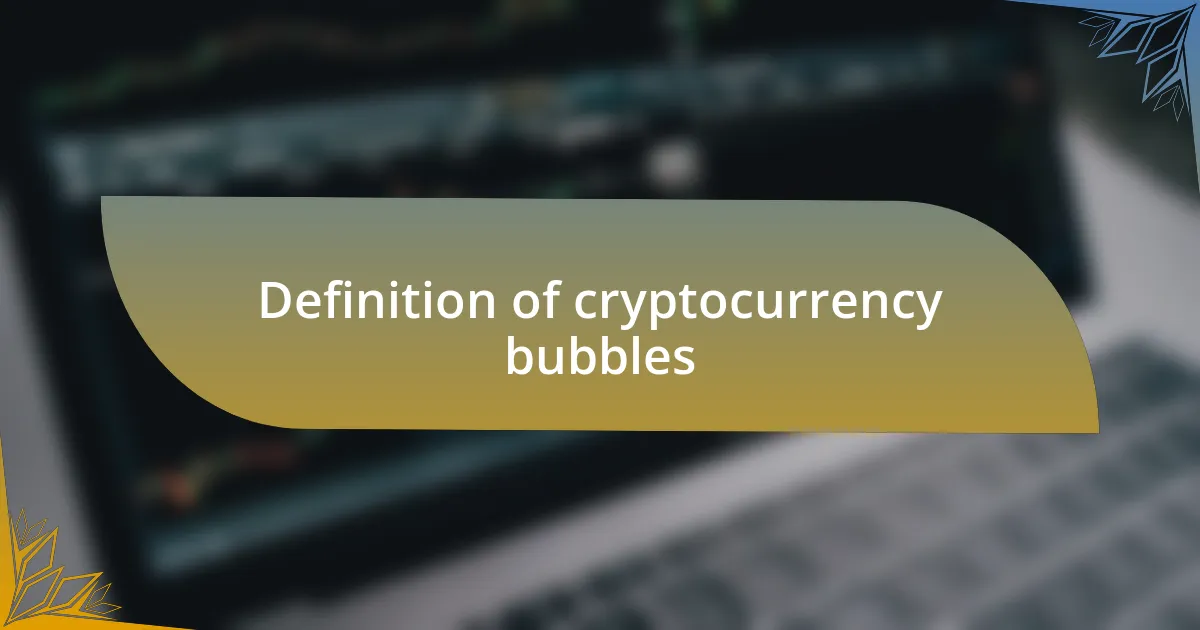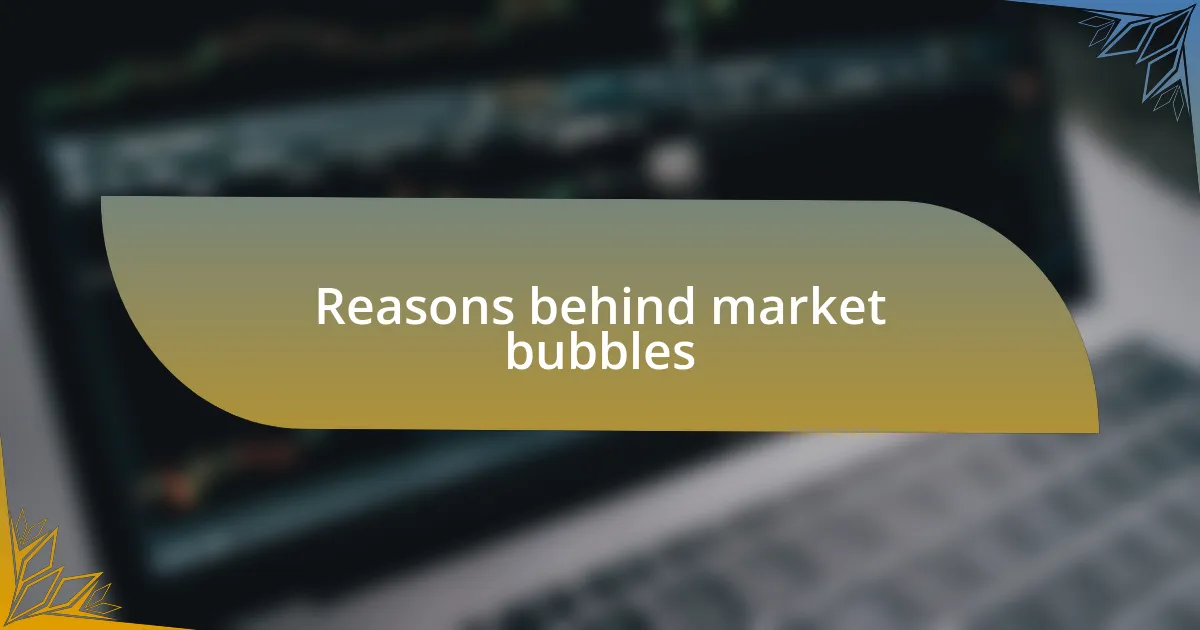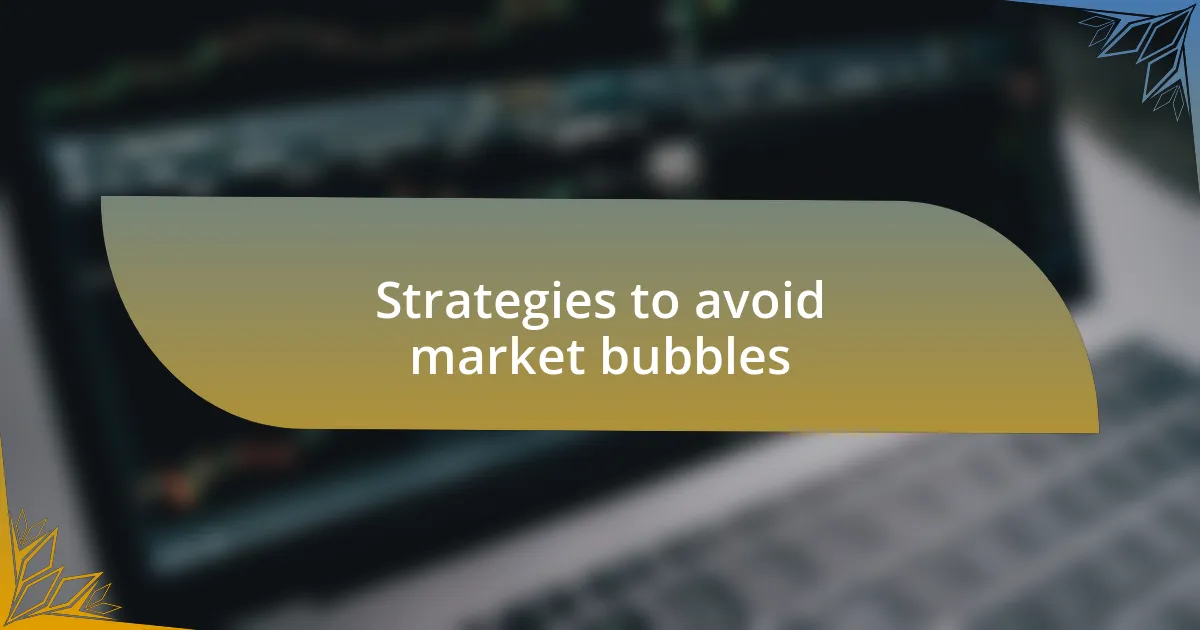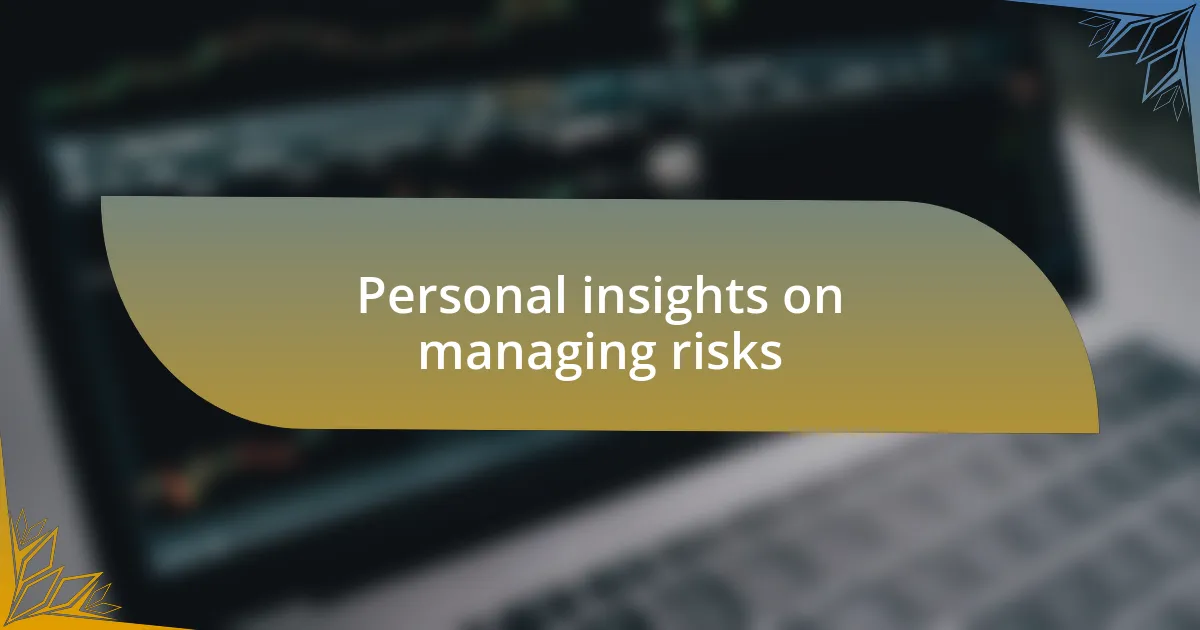Key takeaways:
- Market bubbles arise from speculation, emotional trading, and herd mentality, leading to inflated asset prices beyond intrinsic values.
- Historical examples like the dot-com bubble and Tulip Mania illustrate the dangers of unchecked optimism and the potential for significant losses.
- Effective strategies to avoid bubbles include setting clear investment goals, regularly re-evaluating portfolios, and diversifying investments to mitigate risks.
- Proactive risk management involves recognizing emotional triggers, implementing safety measures like stop-loss orders, and committing to continuous education about market trends.

Understanding market bubbles
Market bubbles occur when the prices of assets, such as cryptocurrencies, inflate beyond their intrinsic values due to excessive speculation and emotional trading. I remember observing the euphoric rise of Bitcoin in late 2017, where people were buying in with the hope that prices would just keep climbing. Was it greed, or the fear of missing out that drove so many to invest without fully understanding the underlying technology?
Digging deeper, these bubbles often create a euphoric mindset where everyone feels like a genius—until reality sets in. I witnessed friends rush to invest during a price surge, and while some made quick profits, others lost substantial amounts when the market corrected. It makes me think: How do we balance hope and caution in such a volatile environment?
As the bubble bursts, panic often ensues, leading to rapid selling and further price declines. It reminds me of the emotional rollercoaster I experienced during a major downturn; it’s tough not to feel overwhelmed when the market takes a nosedive. Understanding these cycles—both the rising and the falling—is essential, because they offer crucial lessons about market behavior and our own responses to fear and excitement.

Definition of cryptocurrency bubbles
Cryptocurrency bubbles are characterized by rapid price increases driven by speculation and herd behavior, where investors chase unrealistic gains without grounding their decisions in fundamental analysis. I remember sitting at my desk, gazing at the skyrocketing numbers on my trading platform, feeling both excitement and a tinge of anxiety as I wondered how sustainable this trend really was. It raises a crucial question: Can we truly separate genuine interest in a technology from mere speculation?
During the peak of a bubble, many individuals often overlook critical market signals, blinded by the thrill of potential riches. I saw so many newcomers to crypto markets fervently discussing the next big coin at social gatherings, almost as if it was a sure bet. This made me wonder: Are we investing in possibilities, or are we simply caught up in a collective dream, hoping it lasts just a little longer?
When the inevitable decline occurs, the harsh reality can be devastating. I’ve experienced the wave of despair that follows a bubble burst, as friends and acquaintances faced profound losses and frustration over investment decisions made in haste. It’s a stark reminder that while the allure of fast profits can be intoxicating, we must remain grounded and approach cryptocurrency investments with a balanced mindset. How do we cultivate a sense of awareness amid the excitement? That, I believe, is one of the key lessons we should carry forward.

Historical examples of market bubbles
During the early 2000s, the dot-com bubble serves as a stark reminder of how hype can overshadow fundamentals. I recall a friend who was convinced that any internet startup would be the next Amazon, pouring money into countless tech stocks without any solid evaluation. When the bubble burst, it left many investors, including him, stunned and deeply regretful, highlighting how fervent optimism can lead us astray.
Another classic example is the Tulip Mania of the 1630s, where prices for tulip bulbs skyrocketed to astronomical levels. Imagine a time when a single tulip bulb could cost as much as a lavish house! The sheer absurdity of it all provides a poignant lesson on the dangers of speculation. I sometimes wonder if the euphoria around certain cryptocurrencies mirrors this historic episode—are we really investing in valuable innovations, or are we merely captivated by the allure of quick riches?
Lastly, the housing market bubble leading up to the 2008 financial crisis is etched in our collective memory. The thrill of home ownership turned into a frenzy, as buyers chased prices that seemed to defy logic. Witnessing friends who lost their homes during that period showed me firsthand how unchecked ambition can have devastating consequences. It makes me reflect: are we seeing similar patterns in today’s crypto landscape?

Reasons behind market bubbles
Market bubbles often spring from a combination of greed and speculation, where investors are driven more by potential profits than by intrinsic value. I remember attending a investing seminar where the speaker zealously touted a new cryptocurrency, urging us to act fast before the next wave of investors drove the price up even more. That atmosphere of urgency can blind us to reality, pushing people to buy based solely on fear of missing out rather than solid research.
Moreover, the role of social media cannot be overlooked. I’ve witnessed firsthand how tweets or viral videos can send a previously stagnant coin soaring overnight. It’s both fascinating and alarming: how does a single tweet hold such power to manipulate market perceptions? This raises an important question for investors— how do we distinguish actionable advice from mere hype?
Finally, government policies and economic conditions can fuel these bubbles too. I recall a period during which regulatory uncertainty fueled rampant speculation as everyone scrambled to invest before potential restrictions took effect. It made me think—how often do we allow external factors to cloud our judgment? When bubbles form, assessing the broader economic landscape becomes crucial to understanding the underlying risks.

Lessons learned from market bubbles
When reflecting on the lessons learned from market bubbles, one key insight is the importance of due diligence. There was a time when I got caught up in the excitement of a trending coin and made impulsive decisions based solely on price movements. I thought I was being savvy, but that rush ultimately led to losses. It taught me that grounding investments in thorough research and fundamental analysis can help avoid the pitfalls of speculation.
Another essential lesson is recognizing the dangers of herd mentality. I remember discussing investments with friends during a bubble, and I felt pressure to join in on the frenzy, fearing I would miss out on potential gains. It struck me how easily we can lose our critical thinking when everyone around us is making the same choices. The experience underscored the importance of maintaining a level head in the face of widespread excitement and fear.
Lastly, I’ve learned that bubbles often serve as a cautionary tale about the volatility inherent in the cryptocurrency market. Each rise usually precedes a sharp decline, which I experienced firsthand. Watching the value plummet after an all-time high left an indelible mark; it reinforced that no asset is immune to correction. This volatile cycle reminds me to stay cautious and prepared for the unexpected, as keeping emotions in check can significantly impact long-term success.

Strategies to avoid market bubbles
One effective strategy to avoid market bubbles is to set clear investment goals and stick to them. I’ve found myself in situations where vague ambitions led to chasing profits based solely on market hype. This approach not only clouds judgment but can also lead to significant losses. Rather than getting swept away by the latest trend, I remind myself of my long-term objectives, which helps maintain focus and discipline.
Implementing a regular schedule for re-evaluating my portfolio is another crucial tactic. During a past bubble, I was tempted to hold onto assets longer than I should have, convinced they would keep climbing. A periodic check allows for necessary adjustments and helps me distance my emotional attachment to specific coins. Could consistent reflection steer my investments away from emotional decisions? Absolutely—this practice has often prevented me from overreacting to fleeting market shifts.
Moreover, diversifying my investments has proven invaluable in mitigating risks associated with bubbles. I vividly remember when a sudden spike in one asset had me glued to my screen, exhilarated yet anxious. By spreading my investments across different coins and sectors, I found a layer of security that helped cushion the blow during downturns. The realization that no single investment should dominate my portfolio was a pivotal moment for me, reinforcing the idea that balance is essential in navigating the unpredictable cycles of the market.

Personal insights on managing risks
Managing risk in the world of cryptocurrency is a delicate balancing act. Once, I found myself heavily invested in a single coin that soared during a bubble; the high made me feel invincible. When its value plummeted, the sinking feeling was all too real. It served as a stark lesson: a robust investment strategy must include not just potential gains but a thoughtful assessment of risk. Are we truly prepared for the unexpected in our portfolios?
In my experience, proactive risk management often requires an emotional reset. There was a time I watched my investments surge into the stratosphere, only to realize that my excitement had clouded my judgment. When I finally stepped back to reevaluate, I felt liberated—acknowledging that fear and greed can lead us astray. Implementing stop-loss orders became a game changer for me; they act as safety nets that keep emotions in check while allowing for growth.
I also learned that educating myself is a cornerstone of managing risk effectively. After diving deep into market trends and historical data, I found it fascinating how many beginners neglect this crucial step. Reflecting on my journey, I can’t help but wonder—what would my decisions have looked like if I’d prioritized knowledge over impulse? Embracing continuous learning not only empowers our choices but significantly enhances our ability to navigate the volatile tides of the market.